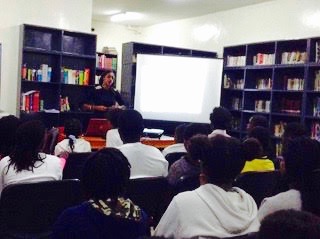Sustainable Development, Through Children’s Eyes
One may think the words “sustainable development” might be abstract and bewildering to children – until meeting the students of the Sustainable Development Club of Le Collège Bilingue in Dakar, Senegal. Week after week, middle and high school students flock to this after-school club that aims to teach them about the benefits of a clean environment as a catalyst to development.
A Trip to the Sustainable Development Club
Last week, I was invited to join the students at their meeting. I arrived with a plan: to share knowledge of sustainable development through the use of IT solutions, DG’s area of expertise. But would the students be able to grasp the benefits of open data? And would they understand the word “transparency” – so essential to my explanation?
To my delight, they did. I offered the Sustainable Development Club a session on development through the implementation of IT solutions. The students were hesitant as they adjusted to a new way of thinking about the SDGs, but lit up as we conducted a case study using the Senegal Aid Management Platform public portal.

Speaking to the Sustainable Development Club
We began by exploring the map, investigating national development activities. To stir up even more interest, I added the Poverty GIS statistical layer, displaying all project sites targeting poverty. Now, all eyes were on the screen…wheels were turning, and I had unlocked a new interest.
After a long, thoughtful silence, the students began peppering me with questions – pertinent ones, at that:
- “What do the different colors on the map mean?”
- “Why are the poorest areas in the country the ones with so few projects?”
- “Why are so many projects concentrated in Dakar?”
The Importance of Contextual Data Analysis
While the answers may seem obvious, we must take caution when answering the questions above. Though using visual tools alone provides a quick, accurate snapshot of reality, doing so can be dangerous in that it provides no context on the data. Taking context into account could change everything, making data analysis truly effective:
|
“Context Case Study”: Casamance, in the Southern region of Senegal The map displays only a few projects in Casamance. There are two possible reasons for this: i) projects information was simply not entered, or ii) Casamance’s small civil war caused donors to suspend activities in the region and shift funding from traditional sectors (health, education, water and sanitation) to a focus on projects funding the safe removal of landmines. Historical context must be included in any data analysis to make sure its conclusions are correct. |
A Few Questions and Answers
While exploring the Health sector on the map, an unexpected question came from the back of the room:
-
“So, why did the President build a new airport, when there are so few health centers in Senegal? A new airport doesn’t seem like a priority to me.”
| I explained short-term vs. long-term objectives. A new airport brings forth long-term city development — valuable new jobs, businesses, and services that might take years to appear. Long-term objectives are differentiated from short term ones in that they rely on many more parameters, actors, and consequences, but still contribute to sustainable development. |
- “Is the Government using this tool? How? Can anybody see this data?”
| Yes — this is a public government tool implemented to promote transparency and to make decisions that allow for more efficient resource allocation. Everybody has access to the tool. |
- “Why do some donors give so much, and others much less?”
| The AMP Senegal dashboards show that the Government of Senegal is the top donor for development activities, which means that Senegal funds many of its own activities. Again, context is very important in analyzing data. Some donors choose to fund big infrastructure projects, while others fund smaller social projects. Depending on the project, amount given varies. To avoid hasty conclusions, we must ensure we consider all parameters. |
A Fresh Perspective
Despite its complexities, sustainable development can be both explained and understood by all ages.

Club Group Photo, after the Presentation
A Note to Development Professionals: Take a moment to step back from your daily nitty-gritty details and “techie” language. Then take another. Maintaining sight of our big-picture shared goals is both refreshing and professionally beneficial. It’s easy to get lost in the details – but to accomplish the SDGs, we need to check in regularly to ensure our small steps are working towards larger goals.
A Note to the Students of the Sustainable Development Club: Keep pushing for a human-friendly environment. Stay engaged, and keep asking questions. Each one of you can make a giant step towards sustaining development in your country, and the world.
Share This Post
Related from our library

The Cancer-Tobacco Link: Using Data to Drive Stronger Tobacco Control Policies
As we observe World Cancer Day today, it is crucial to recognize the significant role smoking plays in the global cancer epidemic. Tobacco use is the leading preventable cause of cancer and cancer-related deaths worldwide, necessitating a dynamic, multidisciplinary approach to tobacco control interventions. DG’s Tobacco Control Data Initiative (TCDI) contains country-specific websites designed to

How useful is AI for development? Three things we learned from conversations with development experts
The development world is buzzing with excitement over the idea that new and emerging applications of artificial intelligence (AI) can supercharge economic growth, accelerate climate change mitigation, improve healthcare in rural areas, reduce inequalities, and more. But what does this look like in real life?

The Future of Technology Governance and Global Development: Why DG Brought DataReady In-house
DG is excited to announce we now have more robust data governance advisory services with the recent integration of DataReady.